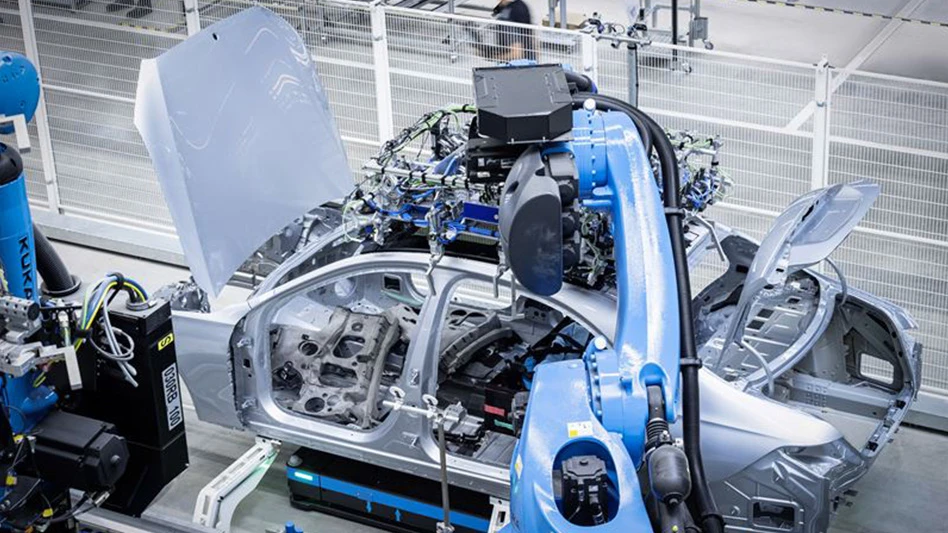
Photo courtesy of Mercedes-Benz AG
Germany-based Mercedes-Benz AG and Sweden-based H2 Green Steel (H2GS) say they have signed a supply agreement for approximately 50,000 tons of green steel annually for the automaker’s European press shops while deepening their partnership through a memorandum of understanding with the aim to establish a sustainable steel supply chain in North America.
Mercedes-Benz says after taking an equity stake in H2GS in 2021, the new supply agreement enables it to bring steel that is nearly free of CO2 into series production. H2GS says production will take place starting in 2025 at its green hydrogen-powered iron and steel plant in Boden, Sweden.
“H2 Green Steel exists because pioneering companies in the automotive industry, like Mercedes-Benz, signaled the transition in the steel industry was too slow for them to meet their climate targets,” H2GS CEO Henrik Henriksson says. “Working side by side with Mercedes-Benz, we have a partner with whom we can raise the bar when it comes to supply chain emissions, circularity and social sustainability. They are a very strong player to liaise with for our European operations, but naturally also as we endeavor into the steel value chain in North America.”
In addition to sustainable production of green steel, the companies say they will create a closed loop for the recycling of scrap steel to the Boden plant. The partnership also includes H2GS being able to leverage Mercedes-Benz’s expertise in supply chain human rights.
“With the supply deal of around 50,000 tons of almost-CO2-free steel from H2 Green Steel for our manufacturing plants in Europe, Mercedes-Benz and H2 Green Steel are accelerating the creation of a decarbonized, regional and resilient steel supply chain,” says Mercedes-Benz Group AG Board of Management member and Chief Technology Officer of Development & Procurement Markus Schafer. “At the same time, we are taking our partnership to the next level with the aim of establishing a sustainable steel supply chain in North America, another important step towards making the auto industry more resilient and sustainability.”
As part of their broader effort to decarbonize the supply chain, the companies have agreed to attempt to establish a supply chain for green steel produced in North America for local Mercedes-Benz manufacturing plants. Mercedes-Benz says the strategic partnership with H2GS in North America marks an important milestone in increasingly pursuing the strategy of procuring close to Mercedes-Benz production sites.
H2GS says in its manufacturing process, the supplier uses hydrogen and electricity from 100 percent-renewable energy sources instead of coking coal in steel production. Hydrogen serves as a reduction gas, which releases and binds the oxygen from the iron ore. The company says unlike the use of coking coal, this produces water vapor instead of CO2, and it aims to achieve a footprint of 0.4 tons of CO2 per ton of steel at the start of supply. It adds that steel produced using a classic blast furnace emits an average of more than two tons of CO2 per ton.
Mercedes-Benz says it is working with all its suppliers toward a net-carbon-neutral supply chain by 2039 at the latest. To achieve this goal, it says it is retooling its supply chain to focus on the prevention and reduction of CO2 emissions rather than offsetting. Currently, the carmaker has introduced low-CO2 steel, made from scrap, into four series models, and recently announced it intends to bring aluminum with almost 70 percent CO2 reduction compared with the European average into series production as the lightweight material is becoming increasingly important for electric vehicles.
At the same time, the company says it plans to increase the share of secondary raw materials in its passenger car fleet to an average of 40 percent. Mercedes-Benz and H2GS have agreed to collaborate on levers to increase the scrap content accordingly.
Latest from Recycling Today
- BMW Group, Encory launch 'direct recycling’ of batteries
- Loom Carbon, RTI International partner to scale textile recycling technology
- Goodwill Industries of West Michigan, American Glass Mosaics partner to divert glass from landfill
- CARI forms federal advocacy partnership
- Monthly packaging papers shipments down in November
- STEEL Act aims to enhance trade enforcement to prevent dumping of steel in the US
- San Francisco schools introduce compostable lunch trays
- Aduro graduates from Shell GameChanger program





